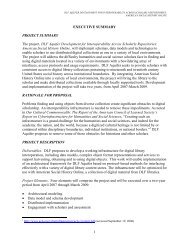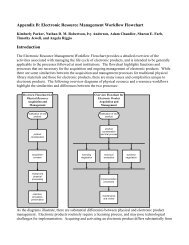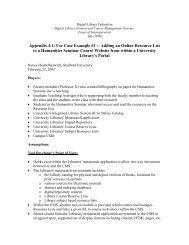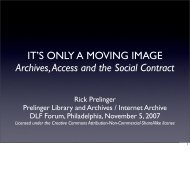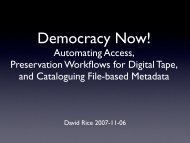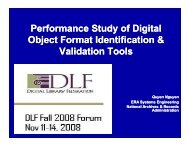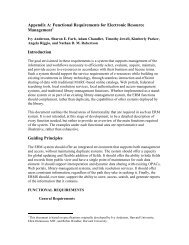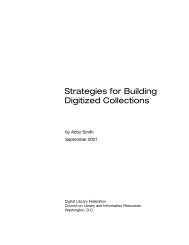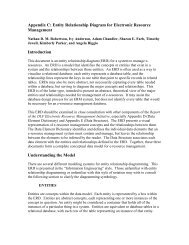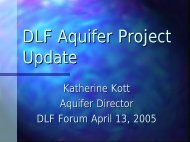Submission Information Package (SIP) - Digital Library Federation
Submission Information Package (SIP) - Digital Library Federation
Submission Information Package (SIP) - Digital Library Federation
You also want an ePaper? Increase the reach of your titles
YUMPU automatically turns print PDFs into web optimized ePapers that Google loves.
3.5.1.6.3 Item-level divisionsTerminal elements are required to wrap the pointers to the individual item-level metadata files(itemid/item-md.xml).AttributesContentParentTYPE=”EJARITEM”LABEL=”citation”ORDERLABEL=”n”Item-level divisionItem-level bibliographic citationItem position within section, e.g., page number,ordinal position, etc.AttributesParentxlink:type=”simple”xlink:href=”itemid/item-md.xml”Item-level METS file pointerPath name of item-level metadata file relative toissue-level directory3.5.2 Issue-level content filesThe issue-level textual content file (issue.xml) is XML-encoded according to the archive EJAR issueschema.Other content files may exist to provide additional issue-level content, such as a cover image. For thepurposes of these additional files, the file names issue-md.xml and issue.xml are reserved.Although file names can be composed using both upper and lower-case characters, all file names must beunique with regard to case-insensitivity. The file extensions established for the normative and nonnormativeformats specified in Appendices B and C must be used.Mathematical notation occurring in the issue-level textual content must be encoded into XML in the formatspecified by the MathML 2.0 specification {MATHML].<strong>SIP</strong> Specification Version 1.0 DRAFT — December 19, 2001 14
3.6 Item-Level File ComponentsEach item-level directory will always contain at least two files: a metadata file (item-md.xml) andeither an item-level textual content file (item.xml) or page description content file (item.pdf). Evenif an XML-encoded textual content file is supplied, a single page description file encapsulating the entireitem should also be provided, if possible. (This file will help to facilitate the quality assurance phase of <strong>SIP</strong>ingest.) If no XML-encoded textual content file is supplied, then the entire item must be encapsulated intoa single page description file. If XML-encoded textual content is supplied, all item-level reference linksare aggregated into a single XML-encoded linkage file (item-links.xml). Additional non-textualitem-level content data such as figures, or supplemental material such as data files, may be present inindividual content files.titleid/issueid/itemid/item-md.xmlitem.xmlitem-links.xmlitem.pdf...(a)titleid/issueid/itemid/item-md.xmlitem.pdf...(b)3.6.1 Item-level metadata fileFig. 3.3 Item-level file components: (a) a single XML-encodedtextual content file and optional supplemental files; or (b) a singlePDF file encapsulating all primary item content; supplementalmaterial is still present in additional files.The item-level metadata file is XML-encoded according to the METS schema, as described in Appendix A.This file contains descriptive, administrative, and technical metadata related to the item and all item-level<strong>SIP</strong> components. An example item-level metadata file is provided in Section A.2.The descriptive, administrative, and structural metadata, and file descriptors for individual item-level <strong>SIP</strong>components are defined independently in the METS framework. The appropriate relationships betweenthese independent sections are specified using the standard XML ID/IDREF mechanism [XML]. Thesesections are each given a unique two-part identifier: an initial section type, and a unique string to identifythe particular component; alphabetic for standard components, numeric for optional components.section:componentType prefixes are defined for descriptive and administrative metadata, and for file descriptor sections:sectiondescradminfileSectionDescriptive metadata ( element)Administrative metadata ( element)File descriptor ( element)Table 3.5 Item-level section type identifiers.component Componentitem Entire issueitem-content Item XML-encoded textual content file (item.xml)item-page Item page description content file (item.pdf)item-links Item reference links file (item-links.xml)n Numeric identifier defined sequentially for optional file components: 1, 2, ...Table 3.6 Item-level section component identifiers.<strong>SIP</strong> Specification Version 1.0 DRAFT — December 19, 2001 15
Thus the identifier for the item descriptive metadata is descr:item; the identifiers for the administrativemetadata and file descriptor for the item-level XML-encoded textual content file are admin:itemcontentand file:item-content; the identifiers for the administrative metadata and filedescriptor for the first optional file component are admin:1 and file:1, etc.The <strong>SIP</strong>-specific element tags and attributes of the item-level metadata file are defined in the followingtables. Elements without any defined content are empty elements: .3.6.1.1 METS rootThe element is the root element of the item-level metadata file. It is the structural parent of allother elements.AttributesContentTYPE=”EJARITEM-version”OBJID=”itemid”LABEL=”citation”PROFILE=”EJAR”...METS root element<strong>SIP</strong> version identifier in the form major.minorItem-level identifierItem-level bibliographic citation3.6.1.2 METS headerThe element captures metadata relative to the item-level metadata file itself, rather than to theabstract <strong>SIP</strong> item object.METS headerAttributes CREATEDATE=”yyyy-mm-dd” item-md.xml file creation dateContent Parent AttributesContentParentROLE=”CREATOR”TYPE=”ORGANIZATION”Depositing agentDepositing agent nameContent publisher Registered name of content providerParent <strong>SIP</strong> Specification Version 1.0 DRAFT — December 19, 2001 16
3.6.1.3 Item-level descriptive metadataThe captures descriptive metadata for the item as a whole.AttributesContentParentID=”descr:item”Item descriptive metadataWrapped item-level descriptive metadata asdefined by the EJAR descriptive metadata schemaThe element is defined in Appendix A. The element represents as-yetundefineddescriptive metadata.3.6.1.4 Item-level administrative metadataAdministrative metadata is captured at very levels of granularity corresponding to the item as a whole andthe specific file components of the item.3.6.1.4.1 Item administrative metadataThis element captures administrative metadata about the item as a whole.AttributesContentParentID=”admin:item”Item administrative metadataContentParentItem rights metadataThe element is defined in Appendix A. The element represents as-yetundefinedadministrative metadata.3.6.1.4.2 Item textual content administrative metadataThis element captures administrative metadata about the item-level XML-encoded textualcontent file (item.xml).AttributesContentParentID=”admin:item-content”Item textual content administrative metadataContentParentItem textual content technical metadataWrapped technical metadata as defined by theEJAR administrative metadata schema<strong>SIP</strong> Specification Version 1.0 DRAFT — December 19, 2001 17
ContentParentItem textual content provenance metadataWrapped checksum as defined by the EJARadministrative metadata schemaThe element is defined in Appendix A. The element represents as-yetundefinedadministrative metadata.3.6.1.4.3 Item page description administrative metadataThis element captures administrative metadata about the item-level page description file(item.pdf).AttributesContentParentID=”admin:item-page”Item page description administrative metadataContentParentItem page description technical metadataWrapped technical metadata as defined by theEJAR administrative metadata schemaContentParentItem page description provenance metadataWrapped checksum as defined by the EJARadministrative metadata schemaThe element is defined in Appendix A. The element represents as-yetundefinedadministrative metadata.3.6.1.4.4 Item reference links administrative metadataThis element captures administrative metadata about the item reference links file (itemlinks.xml).AttributesContentParentID=”admin:item-links”Item reference links administrative metadataContentParentItem reference links technical metadataWrapped technical metadata as defined by theEJAR administrative metadata schemaContentParentItem reference links provenance metadataWrapped checksum as defined by the EJARadministrative metadata schema<strong>SIP</strong> Specification Version 1.0 DRAFT — December 19, 2001 18
The element is defined in Appendix A. The element represents as-yetundefinedadministrative metadata.3.6.1.4.5 Optional item-level component administrative metadataAdditional elements are required to capture administrative metadata about any other optionalitem-level content files.Optional item-level component administrativemetadataAttributes ID=”admin:n” Sequentially assigned numeric identifier: 1, 2, …Content Parent ContentParentOptional item-level component technicalmetadataWrapped component technical metadata asdefined by the EJAR administrative schema orby other appropriate external schemasincorporated normatively into this specificationContentParentOptional item-level component provenancemetadataWrapped component checksum as defined by theEJAR administrative metadata schemaContentParentOptional item-level component rights metadataWrapped component digital rights managementmetadata as defined by the EJAR administrativemetadata schemaThe element is defined in Appendix A. The element represents as-yetundefinedadministrative metadata.3.6.1.5 Item-level file inventoryContentParentItem-level file inventory sectionItem-level file inventoryAttributes ADMID=”admin:item”Content ... Item-level file descriptorsParent The element will contain either: (1) one to three elements, one each for the itemXML-encoded textual content file (item.xml), and optionally, the item page description and reference<strong>SIP</strong> Specification Version 1.0 DRAFT — December 19, 2001 19
links files (item-links.xml); or (2) one element for a single item page description file(item.pdf).3.6.1.5.1 Item XML-encoded textual content, page description, and reference links file descriptorsEither one to three elements must appear together, one each for the XML-encoded textual contentfile, and optionally, the page description and reference links files; or one element must appear byitself for a single page description.AttributesContentParentID=”file:item-content”ADMID=”admin:item-content”CREATED=”yyyy-mm-dd”MIMETYPE=”text/xml”OWNERID=”id”SIZE=”n”Item XML-encoded textual content file descriptorFile creation dateOptional publisher-specific local identifierFile size in bytesAttributesParentItem XML-encoded textual content file locatorxlink:type=”simple”xlink:href=”item.xml”AttributesContentParentID=”file:item-page”ADMID=”admin:item-page”CREATED=”yyyy-mm-dd”MIMETYPE=”application/pdf”OWNERID=”id”SIZE=”n”Item page description file descriptorFile creation dateOptional publisher-specific local identifierFile size in bytesAttributesParentxlink:type=”simple”xlink:href=”item.pdf”Item page description file locatorAttributesContentParentID=”file:item-links”ADMID=”admin:item-links”CREATED=”yyyy-mm-dd”MIMETYPE=”text/xml”OWNERID=”id”SIZE=”n”Item reference links file descriptorFile creation dateOptional publisher-specific local identifierFile size in bytesAttributesParentxlink:type=”simple”xlink:href=”item-links.xml”Item reference links file locator<strong>SIP</strong> Specification Version 1.0 DRAFT — December 19, 2001 20
3.6.1.5.2 Optional item-level content file descriptorAdditional elements are required to capture file descriptor information about any other optionalitem-level content files.AttributesContentParentID=”file:n”ADMID=”admin:n”CREATED=”yyyy-mm-dd”MIMETYPE=”mime”OWNERID=”id”SIZE=”n”Optional item-level file component descriptorSequentially assigned numeric identifier: 1, 2, …File creation dateFile MIME typeOptional publisher-specific local identifierFile size in bytesAttributesParentxlink:type=”simple”xlink:href=”file.ext”Optional item-level file component locatorComponent file name3.6.1.6 Item-level structural metadataAt the item-level the only structural relationship between individual components is aggregation, thus the element contains a single item-level division as the parent of the file referencing elements.AttributesContentParenttype=”LOGICAL”Item-level structural metadataAttributesContentParentTYPE=”EJARITEM”ADMID=”admin:item”DMD=”descr:item”LABEL=”citation”
AttributesParentFILEID=”file:item-links”Item textual content file pointerAttributesParentFILEID=”file:n”Optional item-level file pointer3.6.2 Item-level content filesItem-level content must be either unencapsulated in a set of files; or entirely encapsulated in a single pagedescription file (item.pdf).Under the preferred, unencapsulated scheme, one of item-level files must be a textual content file(item.xml), XML-encoded according to the archive EJAR item schema. The existence of any otheritem-level files is optional. Even if an XML-encoded textual content file is provided, a single pagedescription file (item.pdf) encapsulating the entire item should also be supplied, if possible. (This filewill help to facilitate the quality assurance phase of <strong>SIP</strong> ingest.) For items that contain reference links,those links are contained in a linkage file (item-links.xml), XML-encoded according to the archiveEJAR linkage schema. Additional non-textual item-level files might include figures or data files.Other content files may exist to provide additional item-level content, such as figures. For the purposes ofthese additional files, the file names item-md.xml, item.xml, item-links.xml, and item.pdfare reserved. Although file names can be composed using both upper and lower-case characters, all filenames must be unique with regard to case-insensitivity. The file extensions established for the normativeand non-normative formats specified in Appendices B and C must be used.Mathematical notation occurring in the item-level textual content must be encoded into XML in the formatspecified by the MathML 2.0 specification [MATHML].3.7 <strong>SIP</strong> AggregationAfter the entire <strong>SIP</strong> directory structure has been created and fully populated, the <strong>SIP</strong> is aggregated into asingle file and compressed.cd titleid/..tar cvf issueid.tar titleid/issueidgzip issueid.tarFig. 3.3 <strong>SIP</strong> aggregation and compression (based on Unix tarand gzip).<strong>SIP</strong> Specification Version 1.0 DRAFT — December 19, 2001 22
4 <strong>Submission</strong> SessionA <strong>Submission</strong> Session (SS) is the operational process of submission of a <strong>SIP</strong> to the archive by a contentprovider.The compressed aggregated <strong>SIP</strong> is transmitted to the archive via FTP [FTP]. All content providersregistered with the archive are provided with a unique publisherid and password that must be used forFTP session authentication.cd titleid/..ftp ejar.harvard.eduName: publisheridPassword: ******ftp> binaryftp> cd titleidftp> send issueid.tar.gzftp> quitFig. 4.1 <strong>SIP</strong> <strong>Submission</strong> Session (based on a typical Unixcommand-line oriented ftp client).Distribution of publisherids and passwords occurs as part of the administrative registration proceduresbetween content providers and the archive.4.1 <strong>SIP</strong> IngestAfter the archive has received a <strong>SIP</strong> transmitted by a publisher to the archive in an SS, the <strong>SIP</strong> is processedby the archive Ingest function. This processing includes decompression, disaggregation, verification of allappropriate file components, validation by format, and transformation to normative formats, if appropriate.Once all ingest processing is complete, the archive sends a submission confirmation to the publisher via e-mail indicating the success or failure of the ingest. Invalid <strong>SIP</strong>s that fail during ingest processing are notadded to the archive; the publisher must resubmit the <strong>SIP</strong> with all necessary corrections as indicated in thenegative confirmation message.Following the OAIS functional model, valid <strong>SIP</strong>s successfully passing the Ingest function are transformedinternally into AIPs (Archival <strong>Information</strong> <strong>Package</strong>s), which are then processed by the Archival Storagefunction. After the processing of an AIP by the Archive Storage function, the archive sends an archivalconfirmation to the publisher via e-mail. Only after receiving an affirmative archival confirmation is thepublisher assured that the archive has assumed active archival responsibility for the E-journal contentsubmitted in the <strong>SIP</strong>.<strong>SIP</strong> Specification Version 1.0 DRAFT — December 19, 2001 23
A METS FrameworkMETS (Metadata Encoding and Transmission Standard) is a XML-formatted metadata framework forencoding descriptive, administrative, and structural metadata of digital library objects [METS]. It wasdeveloped as an initiative of the <strong>Digital</strong> <strong>Library</strong> <strong>Federation</strong>, and is built upon work previously performedfor the DLF-funded Making of America II project coordinated at the University of California, Berkeley.The METS mechanisms for defining structural metadata and synchronization were derived in part from TEI[TEI] and SMIL [SMIL]. METS is a metadata framework capturing structural relationships and providingcontainers for descriptive and administrative metadata encoded according to standards external to METSitself.A METS file is composed of five main sections:ElementSectionMETS header, recording information about the METS file itself, not the object the fileabstractly represents.Descriptive metadata section.Administrative metadata section.File inventory section.Structural metadata section.Table A.1 METS main sectionsFor the purposes of the <strong>SIP</strong>, the issue and item-level metadata files (issue-md.xml and item-md.xml)have the following general structure, with global scoping of the METS, EJAR metadata, XML Schema, andXLink namespaces, is: ... Fig. A.1 METS structure.METS does not define the form or encoding of descriptive or administrative metadata elements. Instead, itprovides containers into which externally defined metadata can be placed. XML-encoded metadata can beinserted directly into a METS file by placing it within an metadata wrapper element:<strong>SIP</strong> Specification Version 1.0 DRAFT — December 19, 2001 24
AttributesMIMETYPE=”text/xml”MDTYPE=”type”OTHERMDTYPE=”othertype”Metadata wrapperMETS registered metadata type, or OTHERIf MDTYPE=”OTHER”, non-registered metadatatypeContent Externally defined metadataParent The following metadata types are used in <strong>SIP</strong> issue and item-level metadata files:MDTYPE OTHERMDTYPE Metadata TypeNISOIMGNISO raster still image metadata schema [NISOIMG]OTHER EJAR EJAR descriptive or administrative metadata schemaTable A.1 <strong>SIP</strong> metadata types.<strong>SIP</strong> Specification Version 1.0 DRAFT — December 19, 2001 25
A.1 <strong>SIP</strong> Issue-Level Metadata File (issue-md.xml)The following informative example provides a general example of the form of an issue-level metadata file.Note that this example presupposes the existence of EJAR and NISO namespace-qualified metadataelements whose form has not been standardized as of the time of publication.content providerissue descriptive metadataissue copyright metadataissue content technical metadatacontent file checksum...Fig. A.2(a) <strong>SIP</strong> issue-level metadata file (issue-md.xml)(continued on next page).<strong>SIP</strong> Specification Version 1.0 DRAFT — December 19, 2001 26
...cover image technical metadatacover image copyright metadatacover image checksum.........Fig. A.2(b) <strong>SIP</strong> issue-level metadata file (issue-md.xml)(continued from previous page).<strong>SIP</strong> Specification Version 1.0 DRAFT — December 19, 2001 27
A.2 <strong>SIP</strong> Item-Level Metadata File (item-md.xml)The following informative example provides a general example of the form of an item-level metadata file.Note that this example presupposes the existence of EJAR and NISO namespace-qualified metadataelements whose form has not been standardized as of the time of publication.content provideritem descriptive metadataitem copyright metadataitem content technical metadataitem content file checksum...Fig. A.3(a) <strong>SIP</strong> item-level metadata file (item-md.xml)(continued onto next page).<strong>SIP</strong> Specification Version 1.0 DRAFT — December 19, 2001 28
...item page technical metadataitem page file checksumitem links technical metadataitem links checksumimage technical metadata...image copyright metadataimage checksumdata technical metadata...Fig. A.3(b) <strong>SIP</strong> item-level metadata file (item-md.xml)(continued from previous and onto next page).<strong>SIP</strong> Specification Version 1.0 DRAFT — December 19, 2001 29
...data copyright metadatadata file checksum......Fig. A.3(b) <strong>SIP</strong> item-level metadata file (item-md.xml)(continued from previous page).<strong>SIP</strong> Specification Version 1.0 DRAFT — December 19, 2001 30
B Normative Data FormatsThe normative data formats are those preferred for representing content components within the <strong>SIP</strong>.B.1 Metadata, Issue and Item-Level Text, and Item-Level LinkageFormatXMLVersion 1.0File Extension .xmlMIME typetext/xmlAuthoritativeSpecificationTim Bray, Jean Paoli, C. M. Sperberg-McQueen, and Eve Maler, eds.,Extensible Markup Language (XML) 1.0 (Second Edition), W3CRecommendation, October 6, 2000 .All Unicode characters [UNICODE] outside of the US-ASCII repertoire[USASCII] must be represented in the marked-up text as character references:&#xhhhh;where hhhh is the hexadecimal representation of the character's Unicodecode point. 1All characters outside of the Unicode repertoire must be represented in themarked-up text as named entities drawn from the archive common entity set.Table B.1 Normative metadata and issue and item-level textformat (XML).Beyond conformance to the XML 1.0 standard, certain <strong>SIP</strong> components must also conform to specificXML schemas.B.1.1 Structural Metadata schemaSchemaMETSVersion 1.0Namespacehttp://www.loc.gov/METS/Locationhttp://www.loc.gov/standards/mets/mets.xsdInformativeSpecificationMetadata Encoding & Transmission Standard (METS), Washington, DC:Network Development and MARC Standards Office, <strong>Library</strong> of Congress.Table B.2 Metadata schema.B.1.2 Descriptive and Administrative Metadata schemaSchemaEJARVersion 1.0Namespacehttp://hul.harvard.edu/EJAR/METADATALocationhttp://hul.harvard.edu/EJAR/metadata.xsdInformativeTBDSpecificationTable B.3 Metadata schema.1 ISO/IEC 10646 defines a Universal Character Set (UCS) with a 31 bit encoding. The Unicode Standard[UNICODE] uses a 16 bit encoding. As of 1993 the Unicode repertoire is fully equivalent to the 10646-1Basic Multilingual Plane (BMP) subset.<strong>SIP</strong> Specification Version 1.0 DRAFT — December 19, 2001 31
B.1.3 Issue-level text schemaSchemaEJAR-ISSUEVersion 1.0Namespacehttp://hul.harvard.edu/EJAR/ISSUE/Locationhttp://hul.harvard.edu/EJAR/issue.xsdInformativeTBDSpecificationB.1.4 Item-level text schemaTable B.4 Issue-level text schema.SchemaEJAR-ITEMVersion 1.0Namespacehttp://hul.harvard.edu/EJAR/ITEM/Locationhttp://hul.harvard.edu/EJAR/item.xsdInformativeTBDSpecificationB.1.5 Item-level mathematics DTDTable B.5 Item-level text schema.DTDMathMLVersion 2.0DTD FPI-//W3C//DTD MathML 2.0//ENLocationhttp://www.w3.org/TR/MathML2/dtd/mathml2.dtdInformativeSpecificationDavid Carlisle, Patrick Ion, Robert Miner, and Nico Poppelier, eds.,Mathematical Markup Language (MathML) Version 2.0, W3CRecommendation 21 February 2001 .B.1.6 Item reference links schemaTable B.6 Item-level mathematics DTD.SchemaEJAR-LINKSVersion 1.0Namespacehttp://hul.harvard.edu/EJAR/LINKS/Locationhttp://hul.harvard.edu/EJAR/links.xsdInformativeTBDSpecificationTable B.7 Item reference links schema.<strong>SIP</strong> Specification Version 1.0 DRAFT — December 19, 2001 32
B.2 Raster Still ImageFormatTIFFVersion 6.0File Extension .tifMIME typeimage/tiffAuthoritative Adobe Systems, Inc., TIFF Revision 6.0, final — June 3, 1992 .AdditionalAll TIFF files must contain a single image.RequirementsAll TIFF files must conform fully to all TIFF 6.0 Baseline requirements.RGB full color images must use the Chunky PlanarConfiguration format.Bilevel (1 bit) images must be compressed with ITU T.6 encoding (CCITTFacsimile Group IV) [ITU]. Grayscale, palette-color, and RGB full colorimages must be uncompressed.B.3 Vector Still ImageTable B.7 Normative raster still image format (TIFF).FormatSVGVersion 1.0File Extension .svgMIME typeimage/svg+xmlAuthoritativeSpecificationJon Ferraiolo, ed., Scalable Vector Graphics (SVG) 1.0 Specification, W3CProposed Recommendation, July 19, 2001 .B.4 Page DescriptionTable B.8 Normative vector still image format (SVG).FormatPDFVersion 1.4File Extension .pdfMIME typeapplication/pdfAuthoritative Adobe Systems, Inc, Adobe Portable Document Format, Version 1.3 (2nd ed;Specification Reading, MA: Addison-Wesley, 2000) .___, Errata for PDF Reference, 2nd ed., April 10, 2001 .___, Portable Document Format: Changes from Version 1.3 to 1.4, TechnicalNote #5409 (preliminary), June 11, 2001 .All PDF files must be unencrypted, must have neither an owner or userpassword defined, and must be linearized.Table B.9 Normative page description format (PDF).FormatAIFFVersion 1.3File Extension .aifMIME typeaudio/x-aiffAuthoritativeSpecificationApple Computer, Inc., Audio Interchange File Format: A Standard for SampledSound Files, Version 1.3, January 4, 1989.Table B.10 Audio format (AIFF).<strong>SIP</strong> Specification Version 1.0 DRAFT — December 19, 2001 33
B.6 VideoFormatMPEGVersion 2File Extension .mpgMIME typeapplication/pdfAuthoritativeSpecificationISO/IEC 13818:2000, <strong>Information</strong> technology -- Generic coding of movingpictures and associated audio information. Geneva: ISO, 2000.Table B.11 Video format (MPEG).<strong>SIP</strong> Specification Version 1.0 DRAFT — December 19, 2001 34
C Non-Normative FormatsThe following non-normative formats will be accepted by the archive in a <strong>SIP</strong>, but they will be transformedinto their normative analogues during the ingest process.Component Function Non-Normative Format Normative AnalogueRaster Still ImageGIFTIFF 6.0JPEG (JFIF)Vector Still ImageEncapsulated PostScript * XML 1.0 (SVG 1.0)PostScript *Page DescriptionEncapsulated PostScriptPDF 1.4PostScriptTable C.1 Mappings between non-normative and normativeformats.* Note that PostScript and Encapsulated PostScript will be transformed to SVG only if the instance files arecomposed entirely of vector-oriented images. The inclusion of any raster data will result in the files beingtransformed to PDF.C.1 Raster Still ImageAll <strong>SIP</strong> components received in the following non-normative raster still image formats will be transformedupon ingest into TIFF 6.0.C.1.1 GIFFormatFile ExtensionMIME typeAuthoritativeSpecificationGIF.gifimage/gifCompuServe, GIF Graphics Interchange Format: A Standard Defining aMechanism for the Storage and Transmission of Raster-based Graphics<strong>Information</strong>, June 15, 1987. (Version 87a.)___, Graphics Interchange Format, Version 89a, July 31, 1990.Normative Analogue TIFF 6.0C.1.1 JPEG / JFIFTable C.2 Non-normative raster still image format (GIF).Technically, the JPEG format defines an image compression standard, not a file exchange format. TheJPEG File Interchange Format (JFIF) was developed subsequently to allow file interchange of JPEGencodeddata.FormatFile ExtensionMIME typeAuthoritativeSpecificationJFIF.jpgimage/jpegIndependent JPEG Group, JPEG File Interchange Format, Version 1.02, ed.Eric Hamilton, September 1, 1992 .<strong>Information</strong> Technology — <strong>Digital</strong> Compression and Coding of ContinuoustoneStill Images — Requirements and Guidelines, ITU-T RecommendationT.81, September 1992. Geneva: ITU/CCITT, 1993 .Normative Analogue TIFF 6.0Table C.3 Non-normative raster still image format (JPEG/JFIF).<strong>SIP</strong> Specification Version 1.0 DRAFT — December 19, 2001 35
C.2 Page DescriptionAll <strong>SIP</strong> components received in the following non-normative page description formats will be transformedupon ingest into SVG 1.0, if entirely vector, otherwise PDF 1.4.C.2.1 Encapsulated PostScriptEncapsulated PostScript (EPS) is a format used to encapsulate a single PostScript page image. An EPS fileis a valid PostScript file, subject to additional formatting rules and operator restrictions.FormatFile ExtensionMIME typeAuthoritativeSpecificationNormative AnalogueEPS.epsapplication/postscript(See specifications for PostScript below.)Adobe System, Inc., Encapsulated PostScript (EPS) File Format SpecificationVersion 3.0, Technical Note #5002, May 1, 1992 .XML 1.0 (SVG 1.0) if entirely vectorPDF 1.4if any portion is rasterTable C.4 Non-normative page description format (EPS).C.2.2 PostScriptFormatFile ExtensionMIME typeAuthoritativeSpecificationNormative AnaloguePostScript.psapplication/postscriptAdobe Systems, Inc., PostScript Language Reference Manual. (3rd ed.;Reading, MA: Addison-Wesley, 1999).___, Errata for PostScript Language, 3rd ed., December 8, 2000.XML 1.0 (SVG 1.0) if entirely vectorPDF 1.4 if any portion is rasterTable C.5 Non-normative page description format (PostScript).<strong>SIP</strong> Specification Version 1.0 DRAFT — December 19, 2001 36
References[DOI] The DOI Handbook, Version 1.0.0, International DOI Foundation, February 2001.[FONT] ISO/IEC 9541-2:1991, <strong>Information</strong> Technology — Font <strong>Information</strong> Interchange — Part 2:Interchange Format. Geneva: ISO, 1991.[FTP][ISSN][ITU]J. Postel and J. Reynolds. File Transfer Protocol (FTP), IETF STD 9, RFC 959, October1985 .ISO 3297:1998, <strong>Information</strong> and Documentation — International Standard Serial Number(ISSN). Geneva: ISO, 1998.Facsimile Coding Schemes and Coding Control Functions for Group 4 Facsimile Apparatus,ITU-T Recommendation T.6, November 1988 .[MATHML] David Carlisle, Patrick Ion, Robert Miner, and Nico Poppelier, eds. Mathematical MarkupLanguage (MathML) Version 2.0, W3C Recommendation 21 February 2001.[MD5] R. Rivest. The MD5 Message-Digest Algorithm, IETF RFC 1321, April 1992.[METS]Metadata Encoding & Transmission Standard (METS), Washington, DC: NetworkDevelopment and MARC Standards Office, <strong>Library</strong> of Congress, 2001 .[NISOIMG] Robin Dale and Oya Y. Rieger, eds. Data Dictionary: Technical Metadata for <strong>Digital</strong> StillImages, Working Draft, 1.0, July 5, 2000. Bethesda, MD: NISO, 2000 .[OAIS][SICI][SMIL][TEI]Reference Model for an Open Archival <strong>Information</strong> System (OAIS), CCSDS 650.0-R-1.1 (RedBook). Oxford, UK: Consultative Committee for Space Data Systems, April 20, 2001.NISO/ANSI Z39.56-1996, Serial Item and Contribution Identifier (SICI), Version 2, August14, 1996. Bethesda, MD: NISO Press, 1997 < http://www.techstreet.com/cgi-bin/pdf/free/152629/z39-56.pdf >.Jeff Ayars, Dick Bulterman, Aaron Cohen, Ken Day, Erik Hodge, Philipp Hoschka, EricHyche, Muriel Jourdan, Michelle Kim, Kenichi Kubota, Rob Lanphier, Nabil Layaïda, ThierryMichel, Debbie Newman, Jacco van Ossenbruggen, Lloyd Rutledge, Bridie Saccocio, PatrickSchmitz, and Warner ten Kate, eds. Synchronized Multimedia Integration Language (SMIL2.0), W3C Recommendation 07 August 2001 .C. M. Sperberg-McQueen and Lou Burnard, eds. Guidelines for Electronic Text Encoding andInterchange, Rev. reprint, May 1999 .[TYPE1] Adobe Systems, Inc. Adobe Type 1 Font Format. Reading, MA: Addison-Wesley, 1990. See also Type 1 FontFormat Supplement, Technical Specification #5015, May 15, 1994 < http://partners.adobe.com/asn/developer/pdfs/tn/5015.Type1_Supp.pdf>.[UNICODE] The Unicode Standard, Version 2.0. Reading, MA: Addison-Wesley, 1996.<strong>SIP</strong> Specification Version 1.0 DRAFT — December 19, 2001 37
[URI][UCS][USASCII][XML]T. Berners-Lee, R. Fielding, and L. Masinter. Uniform Resource Identifiers (URI): GenericSyntax, IETF RFC 2396, August 1998 .ISO/IEC 10646-1:2000, <strong>Information</strong> Technology — Universal Multiple-Octet CodedCharacter Set (UCS) — Part 1: Architecture and Basic Multilingual Plane. Geneva: ISO,2000.ANSI X3.4-1986, <strong>Information</strong> Systems —Coded Character Sets — 7-Bit American NationalStandard Code for <strong>Information</strong> Interchange (7-Bit ASCII). New York: ANSI, 1997.Tim Bray, Jean Paoli, C. M. Sperberg-McQueen, and Eve Maler, eds. Extensible MarkupLanguage (XML) 1.0 (Second Edition), W3C Recommendation, October 6, 2000.<strong>SIP</strong> Specification Version 1.0 DRAFT — December 19, 2001 38




